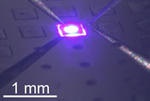Hearing Light
Direktzugriff
Artikelaktionen
Light-emitting diodes produced through thin-film technology, in which semiconductor strata of only a few micrometers thickness are applied to a supporting substrate. Source: Goßler/Fraunhofer IAF
[Translate to English:]
The development of light-emitting diodes that stimulate nerve cells in the cochlea: that is the goal of the fundamental research project “Hearing Light” by Prof. Dr. Ulrich T. Schwarz, Chair for Optoelectronics at the Department of Microsystems Engineering (IMTEK) of the University of Freiburg and group leader at the Fraunhofer Institute for Applied Solid State Physics IAF, and Dr. Patrick Ruther from the Laboratory for Microsystem Materials at IMTEK. The Federal Ministry of Education and Research is funding the project, which is being coordinated by the Fraunhofer IAF.
Hearing impairments are the most common sensory deficit. Around 14 million people suffer from them in Germany alone. Developed in the 1970s, the cochlea implant is a neuroprosthesis that stimulates the nerve cells of the auditory portion of the inner ear, the cochlea, with electric signals. Today these implants are standard treatment for children with inborn hearing impairments. The idea of the “Hearing Light” project is to stimulate the nerve cells through optogenetic rather than electronic means – with the help of micro-light-emitting diodes in the form of linear chains. This approach, which involves stimulating light-sensitive nerve cells in the inner ear, for example with low-intensity blue light, should improve the wearer’s ability to perceive speech melody and music and understand language over background noise. Experiments with mice conducted by the Ear, Nose, and Throat Clinic of the University of Göttingen and the cochlea implant manufacturer MED-EL in Starnberg indicate that this could very well be a promising approach.
Scientists from IMTEK and the Fraunhofer IAF are developing the micro-light-emitting diodes together and integrating them into flexible probes that fit into the tiny canal in the inner ear. The diodes will increase the amount of stimulated canals, enabling an increase in auditory frequency resolution of one to two orders of magnitude. The know-how for producing the flexible and bio-compatible probes comes from the Laboratory for Microsystem Materials at IMTEK, led by Prof. Dr. Oliver Paul. The Fraunhofer IAF is contributing gallium nitride-based micro-light-emitting diodes that are0.01 square millimeters in size and only a few micrometers thick. The two institutes will take on the challenge of integrating the polymer and gallium nitride semiconductor-based processes together.
Contact:
Prof. Dr. Ulrich T. Schwarz
Department of Microsystems Engineering, Chair for Optoelectronics, and Fraunhofer Institute for Applied Solid State Physics IAF
Phone: 0761/5159-513
E-Mail: ulrich.schwarz(at)imtek.uni-freiburg.de, ulrich.schwarz(at)iaf.fraunhofer.de
Katrin Grötzinger
Department of Microsystems Engineering, Communication & Marketing
University of Freiburg
Phone: 0761/203-73242
E-Mail: katrin.groetzinger(at)imtek.uni-freiburg.de
Fußzeile
Benutzerspezifische Werkzeuge

